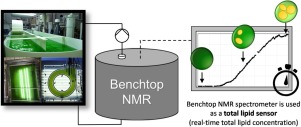当前位置:
X-MOL 学术
›
Process Biochem.
›
论文详情
Our official English website, www.x-mol.net, welcomes your feedback! (Note: you will need to create a separate account there.)
Using benchtop NMR spectroscopy as an online non-invasive in vivo lipid sensor for microalgae cultivated in photobioreactors
Process Biochemistry ( IF 4.4 ) Pub Date : 2020-06-01 , DOI: 10.1016/j.procbio.2020.03.016 Dylan Bouillaud , Delphine Drouin , Benoît Charrier , Corentin Jacquemmoz , Jonathan Farjon , Patrick Giraudeau , Olivier Gonçalves
Process Biochemistry ( IF 4.4 ) Pub Date : 2020-06-01 , DOI: 10.1016/j.procbio.2020.03.016 Dylan Bouillaud , Delphine Drouin , Benoît Charrier , Corentin Jacquemmoz , Jonathan Farjon , Patrick Giraudeau , Olivier Gonçalves

|
Abstract The production of lipids by microalgae is widely studied, especially to find the best bioprocess operating conditions and optimize the productivity of the targeted product. In this context, being able to monitor online the evolution of the lipid concentration is a great advantage regarding the control and/or the optimization of the production. Yet, most non-invasive analyses hit a brick wall on the interference of the lipid signal with the ubiquitous water of the culture medium. This article shows how a compact NMR spectrometer connected to a photobioreactor can circumvent this drawback and measure, in real-time and in a non-invasive manner, the total lipid concentration, and that directly on the entire cells grown in their culture medium. The water signal could be enough-selectively removed using the W5 version of the WATERGATE pulse sequence. The NMR signal nicely correlates (R² > 0.99) with the offline FAME (Fatty Acid Methyl Ester) total lipid analysis as performed by GC-FID (Gas Chromatography coupled to Flame Ionization Detector) within limits of detection and quantification of respectively 9 and 30 mg.L−1. The lipid specific signal appears also quite robust regarding the dissolved dioxygen, making the benchtop NMR spectroscopy an appropriate universal device for the online monitoring of lipids produced in bioprocesses.
中文翻译:

使用台式核磁共振光谱作为光生物反应器中培养的微藻的在线非侵入性体内脂质传感器
摘要 微藻生产脂质已被广泛研究,特别是寻找最佳生物工艺操作条件和优化目标产品的生产率。在这种情况下,能够在线监测脂质浓度的变化是生产控制和/或优化的一大优势。然而,大多数非侵入性分析在脂质信号与培养基中无处不在的水的干扰方面遇到了障碍。本文展示了连接到光生物反应器的紧凑型 NMR 光谱仪如何克服这一缺点,并以实时和非侵入性的方式测量总脂质浓度,并直接测量在其培养基中生长的整个细胞的总脂质浓度。使用 W5 版本的 WATERGATE 脉冲序列可以充分选择性地去除水信号。NMR 信号与离线 FAME(脂肪酸甲酯)总脂质分析密切相关 (R² > 0.99),由 GC-FID(气相色谱与火焰离子化检测器联用)在检测限和定量限分别为 9 和 30 毫克.L-1。对于溶解的分子氧,脂质特异性信号似乎也非常稳定,使台式核磁共振光谱成为在线监测生物过程中产生的脂质的合适通用设备。99) 使用离线 FAME(脂肪酸甲酯)总脂质分析,通过 GC-FID(气相色谱与火焰离子化检测器耦合)在检测和定量限分别为 9 和 30 mg.L-1 内进行。对于溶解的分子氧,脂质特异性信号似乎也非常稳定,使台式核磁共振光谱成为在线监测生物过程中产生的脂质的合适通用设备。99) 使用离线 FAME(脂肪酸甲酯)总脂质分析,通过 GC-FID(气相色谱与火焰离子化检测器耦合)在检测和定量限分别为 9 和 30 mg.L-1 内进行。对于溶解的分子氧,脂质特异性信号似乎也非常稳定,使台式核磁共振光谱成为在线监测生物过程中产生的脂质的合适通用设备。
更新日期:2020-06-01
中文翻译:

使用台式核磁共振光谱作为光生物反应器中培养的微藻的在线非侵入性体内脂质传感器
摘要 微藻生产脂质已被广泛研究,特别是寻找最佳生物工艺操作条件和优化目标产品的生产率。在这种情况下,能够在线监测脂质浓度的变化是生产控制和/或优化的一大优势。然而,大多数非侵入性分析在脂质信号与培养基中无处不在的水的干扰方面遇到了障碍。本文展示了连接到光生物反应器的紧凑型 NMR 光谱仪如何克服这一缺点,并以实时和非侵入性的方式测量总脂质浓度,并直接测量在其培养基中生长的整个细胞的总脂质浓度。使用 W5 版本的 WATERGATE 脉冲序列可以充分选择性地去除水信号。NMR 信号与离线 FAME(脂肪酸甲酯)总脂质分析密切相关 (R² > 0.99),由 GC-FID(气相色谱与火焰离子化检测器联用)在检测限和定量限分别为 9 和 30 毫克.L-1。对于溶解的分子氧,脂质特异性信号似乎也非常稳定,使台式核磁共振光谱成为在线监测生物过程中产生的脂质的合适通用设备。99) 使用离线 FAME(脂肪酸甲酯)总脂质分析,通过 GC-FID(气相色谱与火焰离子化检测器耦合)在检测和定量限分别为 9 和 30 mg.L-1 内进行。对于溶解的分子氧,脂质特异性信号似乎也非常稳定,使台式核磁共振光谱成为在线监测生物过程中产生的脂质的合适通用设备。99) 使用离线 FAME(脂肪酸甲酯)总脂质分析,通过 GC-FID(气相色谱与火焰离子化检测器耦合)在检测和定量限分别为 9 和 30 mg.L-1 内进行。对于溶解的分子氧,脂质特异性信号似乎也非常稳定,使台式核磁共振光谱成为在线监测生物过程中产生的脂质的合适通用设备。


























 京公网安备 11010802027423号
京公网安备 11010802027423号